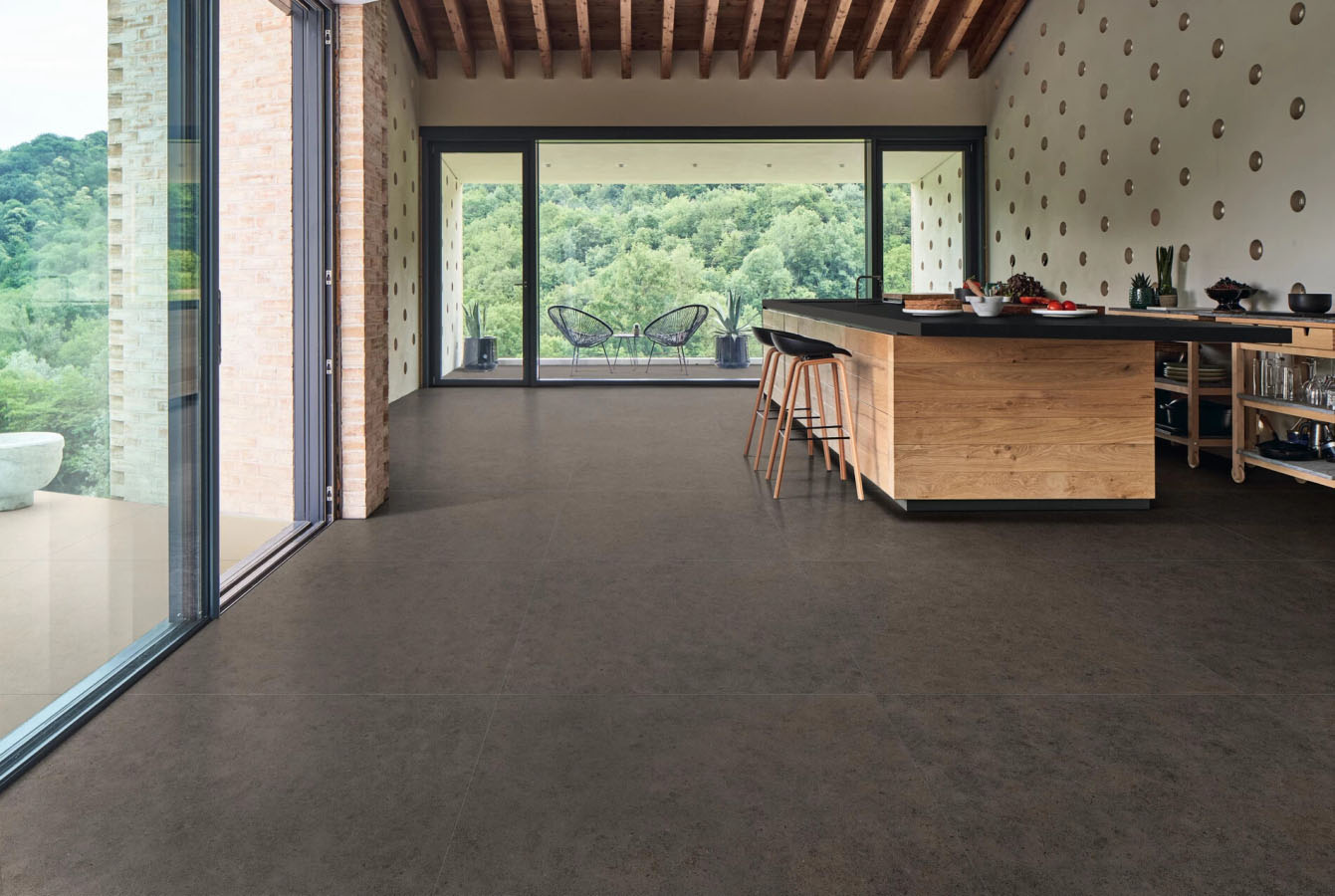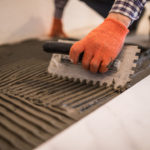Engineered floor tiles
A type of flooring that is engineered with 70% limestone and other flexible materials to
Serve as a perfect alternative to natural stone, porcelain or ceramic tile.
It is endowed with the character and longevity of the traditional tile, but is warmer and softer underfoot.
Where can it be installed?
They can be installed in any space of the house, with or without grout, but they are ideal for areas with high humidity like the kitchen and bathroom.
What is its level of durability?
This type of flooring is built so that it can handle all the needs in the house:
High traffic, spilled liquids, mess and dirt, and even heavy furniture.
No cracks will form in the flooring like the natural ban.
What are the design styles that this flooring offers?
In this flooring you can find many styles from classic slate, through terracotta, travertine and marble to wood-like tiles and more.
These tiles can be found in a variety of shades, shapes and prints.
Flooring for the house – wood
Wood flooring is the most coveted flooring due to its natural beauty, lasting durability and its guidelines.
From the types of flooring for the home offered by the market, in wood flooring you can choose between two types of wood flooring:
Solid beams that are 100% wood, and engineered flooring that is characterized by stable, layered with a backing of a layer of wood on top.
Where can it be installed?
This flooring can be installed in most rooms of the house, although they are not recommended for bathrooms, rooms
Laundry or any other area that is in an area of high humidity and water.
However, engineered flooring can also be a good choice for basement flooring, and for flooring over concrete and over underfloor heating systems.
What is its level of durability?
Even very durable wood can wear out over time, but usually this flooring offers a high lifespan.
The level of difficulty of the different types of wood, the level of protection offered by the finish and the amount of movement
That passes over the floor – will affect the resistance of the wood floor against scratches, dents and stains.
What are the design styles that this flooring offers?
There is a variety of styles, from elegant style to rustic.
This flooring is offered in a variety of colors, effects of finish, textures and sizes.
Whatever style you decide upon, that look can be further enhanced by the type of shutter hinges used.
If you had to choose, which would you prefer – the rich elegance of dark flooring or the airy and clean feeling of light flooring? When choosing between these two extremes, there are quite a few things to consider.
darks
Dark flooring is very fashionable right now. It is dramatic and emphasizes the look and feel of your furniture. Flooring in very dark shades is suitable for open and well-lit rooms – whether it is an office, kitchen, living room or studio. However, if you have installed dark flooring in a space that is not bright enough, you can easily illuminate it by painting the walls a lighter color.
Darker flooring usually also requires more maintenance. Dust and scratches are more noticeable on it than on light-colored flooring. On the one hand, there are those who prefer to see and know exactly how much dirt there is on the floor of the house, on the other hand, it definitely requires more investment. Although it requires cleaning more often, as long as this feature is acceptable to you and you want a bold look that creates a significant contrast between the floor and the walls and highlights the interior design, the dark flooring is right for you.
Light colors
Light flooring is about temporary, classic and comfortable to design around it. It is very versatile in any space, at any ceiling height and in any style of lighting. Because scratches are almost invisible on the light-colored flooring, floors of this type are very good for homes that have pets. The light flooring can contribute to a minimalist look in the Scandinavian style and is very suitable for spaces where cleanliness is important, such as in the kitchen for example. On top of that, brighter surfaces reflect more light and therefore also help to illuminate the space. However, as dirt is more prominent on dark flooring so stains of any kind are more prominent on light surfaces.
Light flooring can make any room look brighter and feel bigger. While the light shades may also look dull and blend in with the background, the atmosphere they soak up is appropriate for any type of room and space, and they have never gone out of fashion. If you want a floor in lighter shades that will not be characterless, look for a flooring that has both different textures and different shades inside.
In conclusion, each shade can be beautiful, but each has its own advantages and disadvantages. If you really have a hard time choosing, first try to decide on the furniture and then it will be easier for you to choose flooring – dramatic furniture in dark colors will require a lighter floor and more solid furniture, will enjoy dark flooring.
Flooring for a house that does not see dirt on it
The kitchen does not treat his floor affectionately. So how can we choose a type of flooring that will require low maintenance ?
The floor in the kitchen suffers from oils and unavoidable stains that are spilled on it while cooking or eating. The kitchen is also exposed to extreme heat conditions and is home to heavy appliances that have not been moved for years. In addition, if sharp or heavy objects fall to the floor, such as knives, cans or pans, they may puncture or break the flooring.
The flooring materials chosen for the kitchen floor, should be able to withstand the daily rigidity that attacks the floor mercilessly.
We are usually looking for flooring for a home that does not see dirt, one that is relatively easy to clean and care for, one that will allow us to spend more time cooking and less time cleaning and scrubbing the floor. Here are some suggestions on how to look or get an appointment for antique items in your kitchen:
Natural stone
Natural stone refers to a variety of materials that are extracted from the soil and then processed into architectural elements. Naturally, different types of stone will have different properties. Marble for example is very soft, easily scratched and may be stained by various liquids.
When looking for low-maintenance kitchen flooring, you should choose materials like slate or granite.
These are very hard stones, and with proper sealing they are also almost completely impermeable to water. These stones are scratch-resistant, although cracks may appear in them when something heavy falls on them or if the flooring has not been installed properly.
Multicolored slate tiles or granite tiles can save cleaning time also because of their mottled surface, which tends to hide dirt and imperfections. With these tiles
You can spend less time making the kitchen look clean and free of stains disguised by the colors.
It is important to periodically seal a natural stone floor in the kitchen, so that the floor will withstand water damage and stains over time.
ceramic tiles
Ceramic flooring instills a look and feel of natural stone but is impervious to moisture penetration. The floor is cleaned by a broom or damp cloth, and in case of stain it can be removed with a suitable detergent. In the case of these tiles there is no need to worry about sealing the tiles themselves, although it is important to reduce the spaces between the tiles to reduce the possibility of mold development.
Concrete flooring
It is very easy to care for and maintain a concrete floor in the kitchen. This is because it is a strong, durable, and tough enough material to provide a foundation for the entire structure. Because concrete is a very tough material, it is quite difficult to scratch or crack it, and even if it does, repair is usually quick and fairly inexpensive.
The only problem with concrete in the kitchen is the fact that it is a permeable material. That means liquids can seep into the floor. Fortunately, the concrete floor can be sealed with a special material that creates an invisible layer and makes the concrete less porous.


